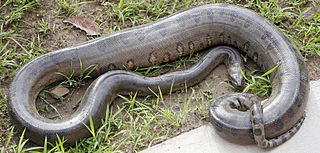
Anacondas or water boas are a group of large snakes of the genus Eunectes. They are found in tropical South America. Four species are currently recognized.

Boa is a genus of boas found in Mexico, the Caribbean, and Central and South America. Five extant species, and one extinct, are currently recognized.
Constriction is a method used by several snake species to kill or subdue their prey. Although some species of venomous and mildly venomous snakes do use constriction to subdue their prey, most snakes which use constriction lack venom. The snake strikes at its prey and holds on, pulling the prey into its coils or, in the case of very large prey, pulling itself onto the prey. The snake then wraps one or two loops around the prey, forming a constriction coil. The snake monitors the prey's heartbeat to ascertain it is dead. This can be a physically demanding and potentially dangerous procedure for the snake, because its metabolism is accelerated up to sevenfold and it becomes vulnerable to attack by another predator.

Xenopeltis, the sunbeam snakes, are the sole genus of the monotypic family Xenopeltidae, the species of which are found in Southeast Asia. Sunbeam snakes are known for their highly iridescent scales. Three species are recognized, each one with no subspecies. Studies of DNA suggest that the xenopeltids are most closely related to the Mexican burrowing python and to the true pythons (Pythonidae).

The green anaconda, also known as the giant anaconda, emerald anaconda, common anaconda, or common water boa, is a boa species found in South America and the Caribbean island of Trinidad. It is the largest, heaviest and the second longest snake in the world. No subspecies are currently recognized. Like all boas, it is a non-venomous constrictor.

The Calabar python is a species of non-venomous snake in the family Boidae. The species is endemic to West and Central Africa. It is the only species in its genus.
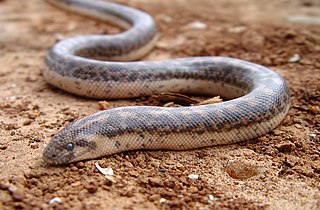
The Erycinae, also known as the Old World sand boas, are a subfamily of nonvenomous snakes in the family Boidae. Species of the subfamily Erycinae are found in Europe, Asia Minor, Africa, Arabia, central and southwestern Asia, India, Sri Lanka, and western North America. Four genera comprising 18 species are currently recognized as being valid.

Sanzinia madagascariensis, also known as the Madagascar tree boa or Malagasy tree boa, is a boa species endemic to the island of Madagascar. It was once considered conspecific with the Nosy Komba ground boa. Like all other boas, it is non-venomous.

Acrantophis dumerili, commonly known as Dumeril's boa, is a species of non-venomous snake in the family Boidae. The species is endemic to Madagascar. No subspecies are currently recognized.

Acrantophis madagascariensis is a species of boid snake in the subfamily Sanziniinae that is endemic to the island of Madagascar. Its common names include the Madagascar ground boa and Malagasy ground boa.

The Boinae are a purported subfamily of boas found in Central and South America, as well as the West Indies. In the Integrated Taxonomic Information System (ITIS), Boinae is considered an invalid synonym of Boidae.
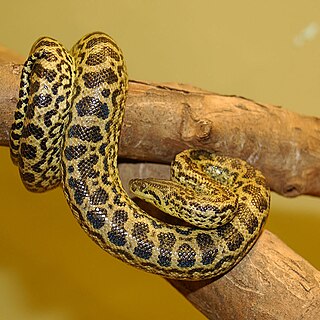
The yellow anaconda, also known as the Paraguayan anaconda, is a boa species endemic to southern South America. It is one of the largest snakes in the world but smaller than its close relative, the green anaconda. No subspecies are currently recognized. Like all boas and pythons, it is non-venomous and kills its prey by constriction.

The Cuban boa, also known as the Cuban tree boa and by locals as maja de Santa María, is a very large species of snake in the family Boidae. With lengths exceeding 5 m (16 ft) and a relatively heavy build, the Cuban boa is one of the largest snakes in the world. The species is native to Cuba and some nearby islands. No subspecies are currently recognized.

Eunectes is a genus of boas found in tropical South America commonly called anacondas. They are a semiaquatic group of snakes and include one of the largest snakes in the world, E. murinus, the green anaconda. Four species are currently recognized.

Eunectes deschauenseei, commonly known as the dark-spotted anaconda or De Schauensee's anaconda, is a species of snake in the subfamily Boinae of the family Boidae. The species is native to northeastern South America. Like all boas, it is a nonvenomous constrictor. No subspecies are currently recognized.
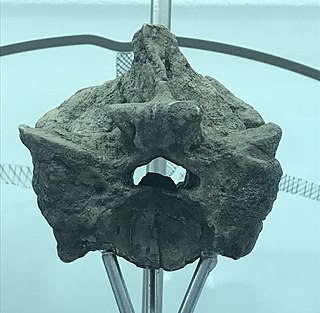
Titanoboa is an extinct genus of giant boid, the family that includes all boas and anacondas, snake that lived during the middle and late Paleocene. Titanoboa was first discovered in the early 2000s by the Smithsonian Tropical Research Institute who, along with students from the University of Florida, recovered 186 fossils of Titanoboa from La Guajira in northeastern Colombia. It was named and described in 2009 as Titanoboa cerrejonensis, the largest snake ever found. It was originally known only from thoracic vertebrae and ribs, but later expeditions collected parts of the skull and teeth. Titanoboa is in the subfamily Boinae, being most closely related to other extant boines from Madagascar and the Pacific.
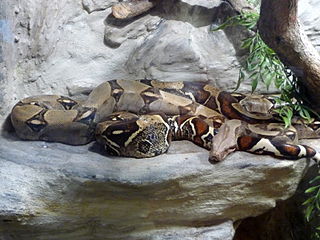
The boa constrictor, also known as the common boa, is a species of large, non-venomous, heavy-bodied snake that is frequently kept and bred in captivity. The boa constrictor is a member of the family Boidae. The species is native to tropical South America. A staple of private collections and public displays, its color pattern is highly variable yet distinctive. Four subspecies are recognized. This article focuses on the species Boa constrictor as a whole, and on the nominate subspecies B. c. constrictor.

Eunectes beniensis is a boa species known only from the northeastern parts of Bolivia. Its common names, the Bolivian anaconda and Beni anaconda, are derived from the geographic location of its native habitat: the Beni area of Bolivia. Like all boas, it is nonvenomous.

The Booidea, also known as booid snakes, are a superfamily of snakes that contains boas and other closely related boa-like snakes. As of 2017, Booidea contains 61 species, including the eponymous neotropical Boa constrictor, anacondas, and smaller tree and rainbow boas as well as several genera of booid snakes from various locations around the world: bevel-nosed boas or keel-scaled boas (Candoia) from New Guinea and Melanesia, Old World sand boas (Eryx) from Northeast Africa, the Middle East, and Southwest Asia, rubber boas (Charina) and rosy boas (Lichanura) from North America, neotropical dwarf boas (Ungaliophis) and the Oaxacan dwarf boa (Exiliboa) from Central America, Madagascan boas or Malagasy boas from Madagascar, and the Calabar python (Calabaria) from tropical West-Central Africa.






























